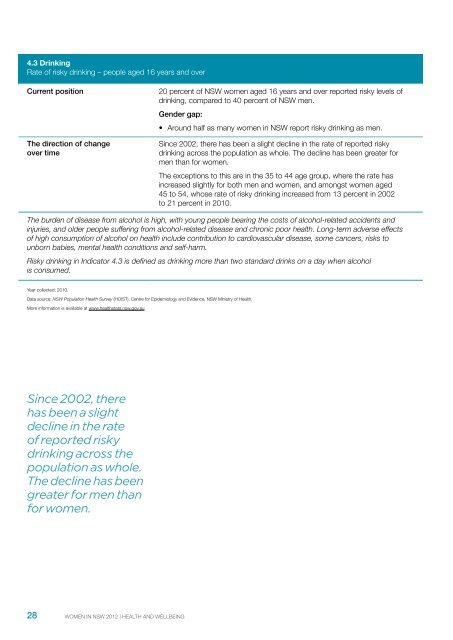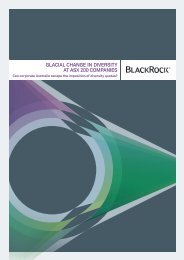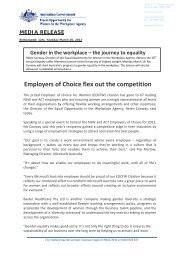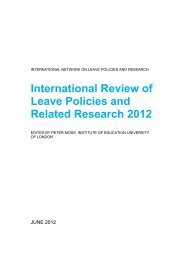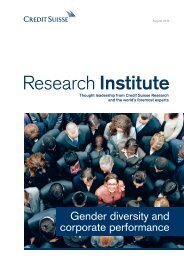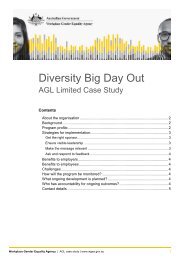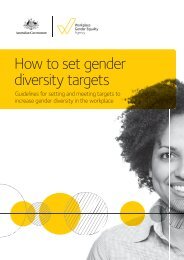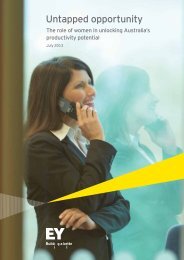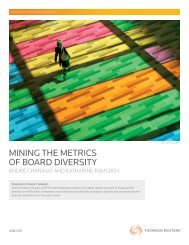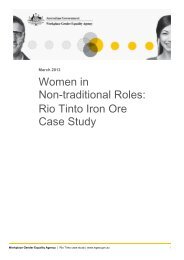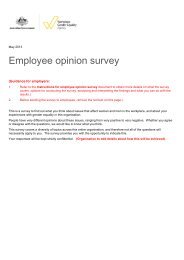Women in NSW 2012 - The Workplace Gender Equality Agency
Women in NSW 2012 - The Workplace Gender Equality Agency
Women in NSW 2012 - The Workplace Gender Equality Agency
Create successful ePaper yourself
Turn your PDF publications into a flip-book with our unique Google optimized e-Paper software.
4.3 Dr<strong>in</strong>k<strong>in</strong>gRate of risky dr<strong>in</strong>k<strong>in</strong>g – people aged 16 years and overCurrent position<strong>The</strong> direction of changeover time20 percent of <strong>NSW</strong> women aged 16 years and over reported risky levels ofdr<strong>in</strong>k<strong>in</strong>g, compared to 40 percent of <strong>NSW</strong> men.<strong>Gender</strong> gap:• Around half as many women <strong>in</strong> <strong>NSW</strong> report risky dr<strong>in</strong>k<strong>in</strong>g as men.S<strong>in</strong>ce 2002, there has been a slight decl<strong>in</strong>e <strong>in</strong> the rate of reported riskydr<strong>in</strong>k<strong>in</strong>g across the population as whole. <strong>The</strong> decl<strong>in</strong>e has been greater formen than for women.<strong>The</strong> exceptions to this are <strong>in</strong> the 35 to 44 age group, where the rate has<strong>in</strong>creased slightly for both men and women, and amongst women aged45 to 54, whose rate of risky dr<strong>in</strong>k<strong>in</strong>g <strong>in</strong>creased from 13 percent <strong>in</strong> 2002to 21 percent <strong>in</strong> 2010.<strong>The</strong> burden of disease from alcohol is high, with young people bear<strong>in</strong>g the costs of alcohol-related accidents and<strong>in</strong>juries, and older people suffer<strong>in</strong>g from alcohol-related disease and chronic poor health. Long-term adverse effectsof high consumption of alcohol on health <strong>in</strong>clude contribution to cardiovascular disease, some cancers, risks tounborn babies, mental health conditions and self-harm.Risky dr<strong>in</strong>k<strong>in</strong>g <strong>in</strong> Indicator 4.3 is def<strong>in</strong>ed as dr<strong>in</strong>k<strong>in</strong>g more than two standard dr<strong>in</strong>ks on a day when alcoholis consumed.Year collected: 2010.Data source: <strong>NSW</strong> Population Health Survey (HOIST), Centre for Epidemiology and Evidence, <strong>NSW</strong> M<strong>in</strong>istry of Health.More <strong>in</strong>formation is available at www.healthstats.nsw.gov.auS<strong>in</strong>ce 2002, therehas been a slightdecl<strong>in</strong>e <strong>in</strong> the rateof reported riskydr<strong>in</strong>k<strong>in</strong>g across thepopulation as whole.<strong>The</strong> decl<strong>in</strong>e has beengreater for men thanfor women.28 WOMEN IN <strong>NSW</strong> <strong>2012</strong> | HEALTH AND WELLBEING


